Crucial SSDs are among the most popular storage solutions in the world. You can store your favorite memories in one place and access them whenever. But what happens if your SSD suddenly starts acting up and you lose some of your precious files? Is there a way to get your treasure back?
Today's guide will dive deep into all Crucial SSD data recovery methods you can try to retrieve your files, but first, you need to understand what may cause data loss in the first place.
Table of Content
Common Causes of Crucial SSD Data Loss
Numerous reasons may stand behind data loss on SSDs, and here are some of them:
| Causes | Recovery Possibility |
| Accidental Deletion | One of the most common reasons behind SSD data loss is accidental deletion. You may have wanted to clean up your drive and free up space for new memories but have deleted the wrong files. The only thing that can save you from this scenario is a powerful data recovery software. |
| Formatting | Formatting is preparing the SSD or a drive for further use, so if you use an incompatible file system during the formatting process, your drive will eventually experience issues, such as failure or data loss. Before formatting, check whether you're using the correct file system. Before formatting the Crucial SSD, you should recover your data with a reliable data recovery software solution. |
| SSD Corruption | Your data may become corrupted due to viruses and malware, physical damage, incompatible file system, software issues, and numerous other issues. Once the data becomes corrupted, it may vanish, or you may have issues accessing your valuables through your desktop device. The best way to recover data from such scenarios is by using a reliable data recovery software solution. Afterward, you can format it to regain usability. |
| Failing Firmware | The Crucial SSD firmware is responsible for communication between your device and the operating system. If the firmware starts to fail, you won't be able to access your SSD and its data. Some severe cases of firmware failure will lead to data loss and performance issues. You should first use a data recovery solution and then update the firmware to give it a fresh start. |
| Hardware Problems | If your Crucial SSD has experienced physical damage, it may become inaccessible and delete some of your files. For instance, if the SSD has been exposed to humidity, water, drops, and dirt, it may lead to file deletion and slower performance. You should check for physical damage to determine whether this is causing the issue. In this case, you may want to check for physical damage, use a reliable recovery tool, or contact Crucial professionals for help. |
How To Recover Data From Crucial SSD Using a Reliable Recovery Tool
You'll need a reliable SSD data recovery software to recover data from the abovementioned data loss scenarios. The market is filled with tools promising incredible success rates and recoveries, but the reality is much different. Some of these tools won't provide deep scans that can extract valuables from some of the most complicated loss scenarios.
After researching the market thoroughly and testing dozens of popular recovery tools, we've concluded that Wondershare Recoverit is the best solution. This feature-packed program was able to deal with all Crucial SSDs data loss scenarios we threw its way and was the most successful solution overall.
- Recovers data from all popular SSD brands, including Crucial, LaCie, WD, Samsung, SanDisk, etc.
- Manages over 500 data loss situations, such as deletion, formatting, disk corruption, virus attack, and system crash.
- Compatible with various SSD file systems, including exFAT, FAT32, NTFS, HFS+, APFS, EXT4, etc.

If you decide to use Wondershare Recoverit for your Crucial SSD data recovery journey, you should first head to the official Wondershare Recoverit website and download the tool. Then, follow the steps below for the most successful journey:
- Open the app and choose the Hard Drives and Locations option.
- Select your SSD from the list of available options.

- Once you've selected the SSD, the program will automatically start scanning the location. You can pause this process if needed.

- While the program is scanning, you can filter your files by their type and size.

- After the Crucial SSD recovery tool finishes scanning, you can preview the recovered files and select the ones you want to save. Click the Recover button.
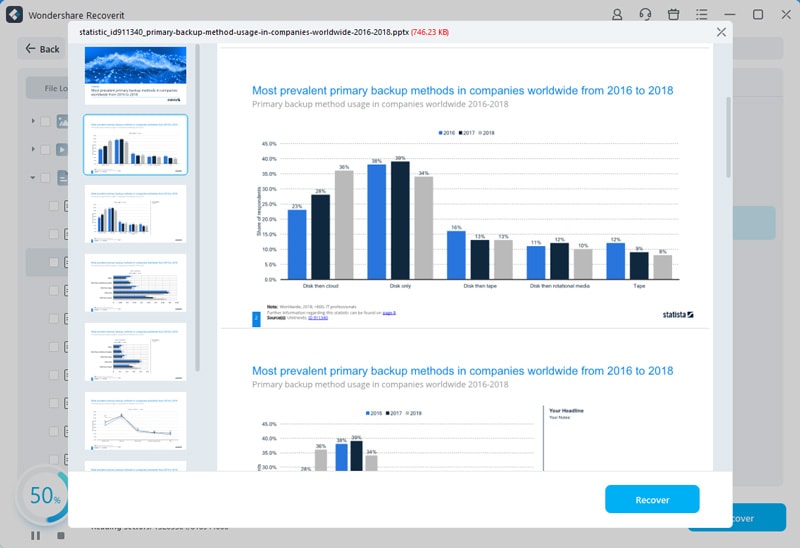
- Choose where to save the files.

It will only take you a few minutes to regain access to your valuable data, thanks to Wondershare Recoverit's advanced algorithms and systems.
How To Recover Data From Internal Crucial SSD When the PC won't Boot
Recoverit is also capable of recovering data from crashed computers. If you're using an internal Crucial SSD and it won't allow you to boot your device, we have just the right solution for you. You'll need a blank USB flash drive and a working computer to make the recovery possible.
Download Recoverit to the working computer and follow the steps below:
- Open Recoverit and click on System Crashed Computer. Select Start.
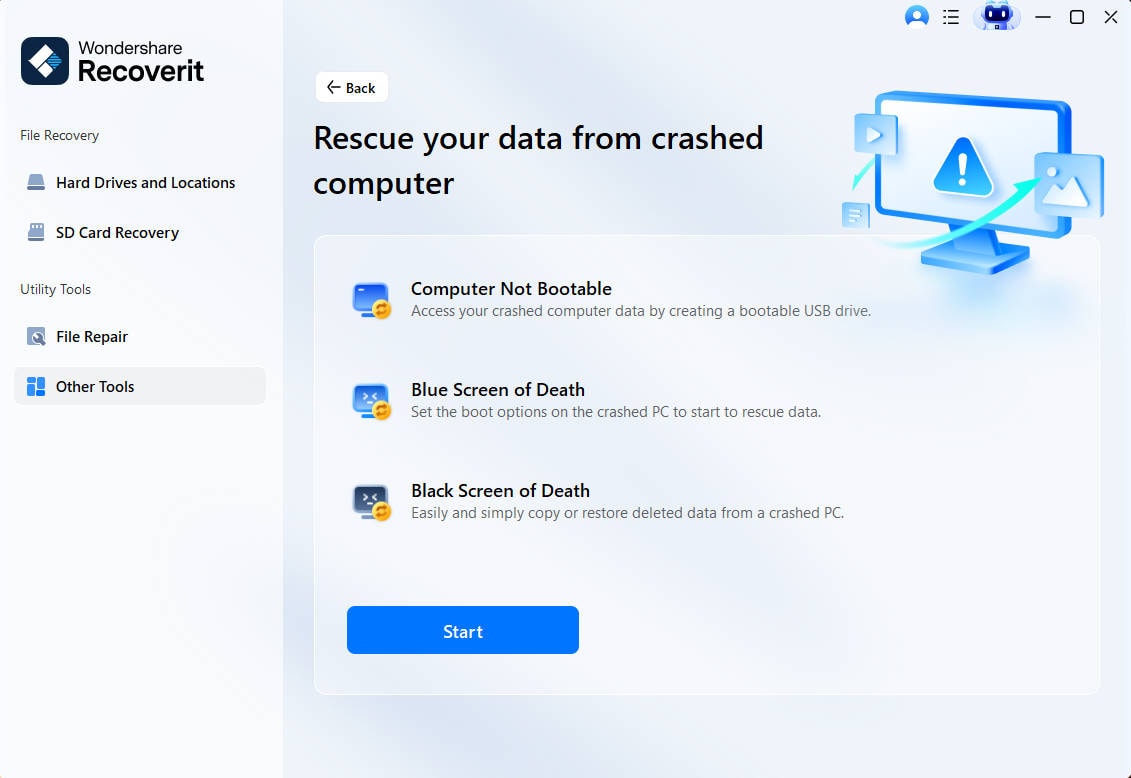
- Insert your blank USB flash drive into the working computer.
- Select your USB from the available options.

- After selecting the drive, the program will ask you to format the drive. Click the Format button to continue.
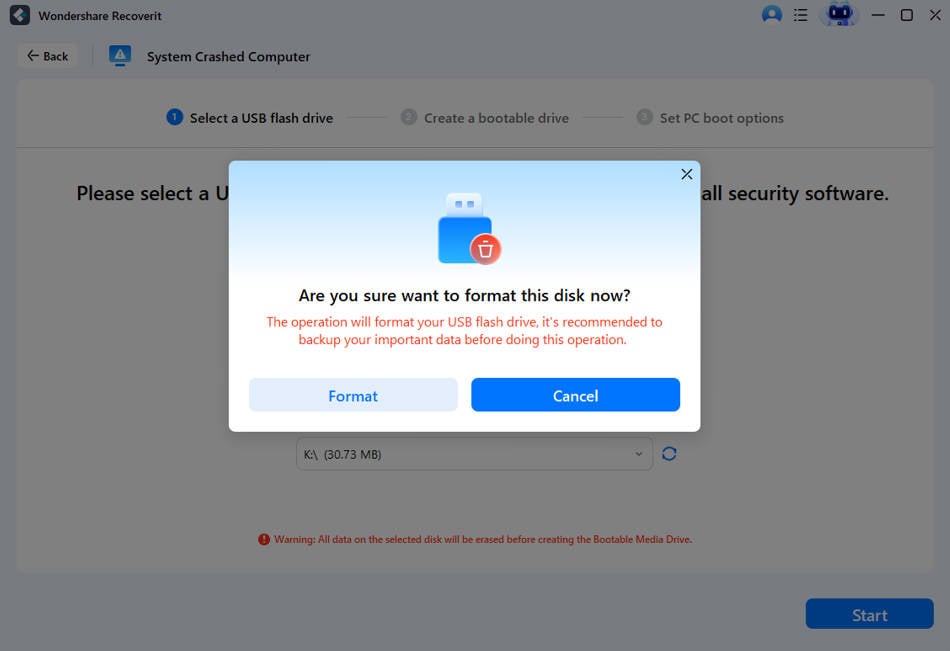
- Once the program finishes formatting, it'll start creating a bootable drive. Don't remove the USB during this process.
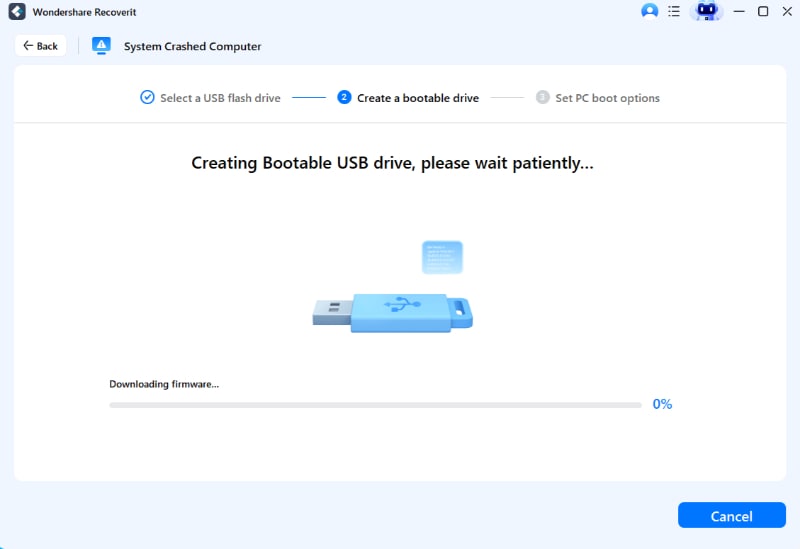
- After this, you can take out your USB and insert it into the crashed computer.
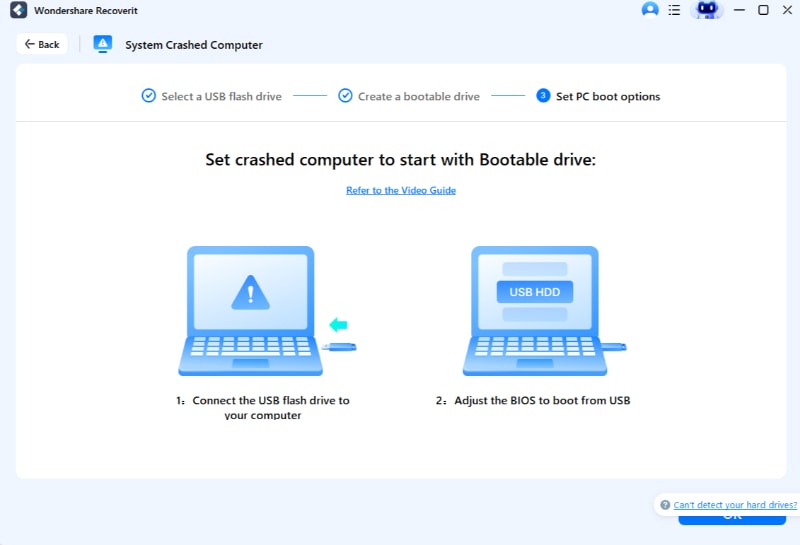
- Adjust the BIOS to boot from the inserted USB flash drive.
- Once the PC turns on, choose between Hard Disk Copy and Data Recovery.
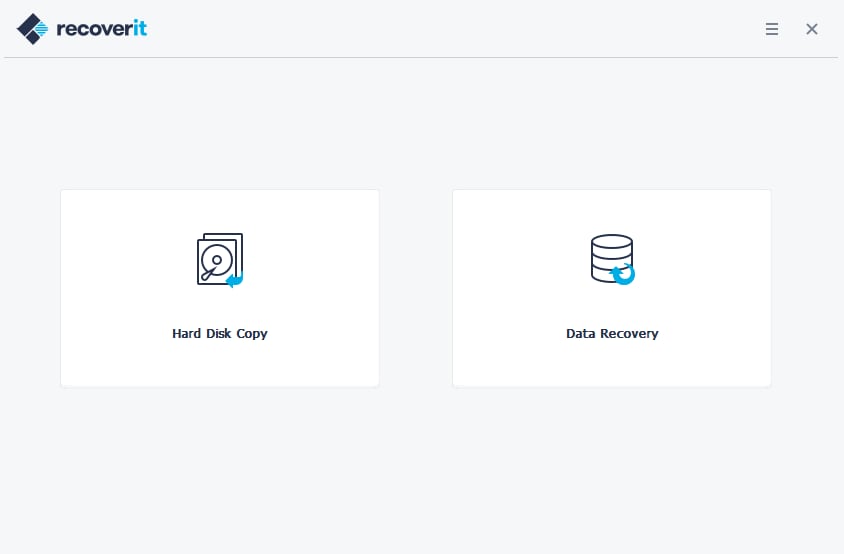
For Hard Disk Copy, follow the steps below:
- Choose the copy directory.
- Connect a good drive to the crashed computer.
- Choose the connected hard drive from the available options, and click Copy.
For Data Recovery:
- Choose a disk to scan.
- Connect a good hard drive to the crashed computer.
- Choose where to save the recovered files and click the Recover button.
How To Recover Data From Crucial SSD Without Access
If you cannot access your SSD and your data, you can try some of the methods mentioned below.
Format the Drive
If you have been using an incorrect file system, your SSD may become unrecognizable and inaccessible after some time. Moreover, if you're dealing with corruption or software issues, formatting the drive will give you a fresh start and make your SSD as good as new.
The problem with formatting your SSD is that you'll lose all of the data stored on this device. This process will wipe away everything from the drive to give it a new life. Thus, you'll need a recovery tool for this process to ensure you can recover all of your valuables. Here's how to format your SSD:
- Right-click on the Windows startup button and select Disk Management.

- Find the SSD you want to format and right-click on it.
- Choose Format from the drop-down menu.

- In the next window, select the file system (usually NTFS).

- Check the Perform a Quick Format box and click OK.

After formatting the Crucial SSD drive, you should restart your device.
Moreover, you should tick the Perform a Quick Format box since it won't overwrite your data. It means that data recovery will still be possible after formatting. After performing a format, use a reliable recovery tool, such as Wondershare Recoverit, to extract your data.
Update SSD Drivers
Keeping your SSD drivers up-to-date is crucial for the drive's performance and health. If the drivers are updated regularly, it's less likely that you'll lose your data, so perform this action frequently and take care of your SSD. Here's how to update the drivers on a Windows device:
- Open Device Manager.

- Find your Crucial SSD (usually under Disk Drives) and right-click on it.
- Select Update Driver from the drop-down menu.

The process for updating the drivers on Mac is a bit different. You don't have a designated option for updating the drivers. Instead, you'll have to update your software, which will automatically update your SSD. Here's how to do it:
- Click on the Apple menu and open System Preferences/System Settings.

- Head to General.

- Find the Software Update option.

- Click the Update Now button to start the update process.

Update Crucial SSD Firmware
Updating the Crucial SSD firmware means updating the software used to control your SSD. Keeping the firmware up-to-date is crucial for protecting the drive from potential threats, corruption, and data loss. You should download the update as soon as it's available for the best results and the happiest SSD.
The update process and guide will depend on the make and model of your Crucial SSD. Crucial SSDs come with their native programs where you can control your SSD, see the usage, and free up space. You can use the same program to update your firmware and resolve inaccessibility issues caused by an outdated element.
Conclusion
Realizing something's wrong with your Crucial SSD and data may be panic-inducing, especially if you have no experience in the data loss field. If so, don't worry - you can still get your valuables back and repair your SSD with the help of the right tools and methods. We have discussed the most reliable data recovery ways you can try to bring your data back home.
The most reliable and successful tool you can use in such scenarios is Wondershare Recoverit. It's an all-in-one tool that will meet all your recovery needs. You can keep it as a backup plan if you lose your data again.


 ChatGPT
ChatGPT
 Perplexity
Perplexity
 Google AI Mode
Google AI Mode
 Grok
Grok























